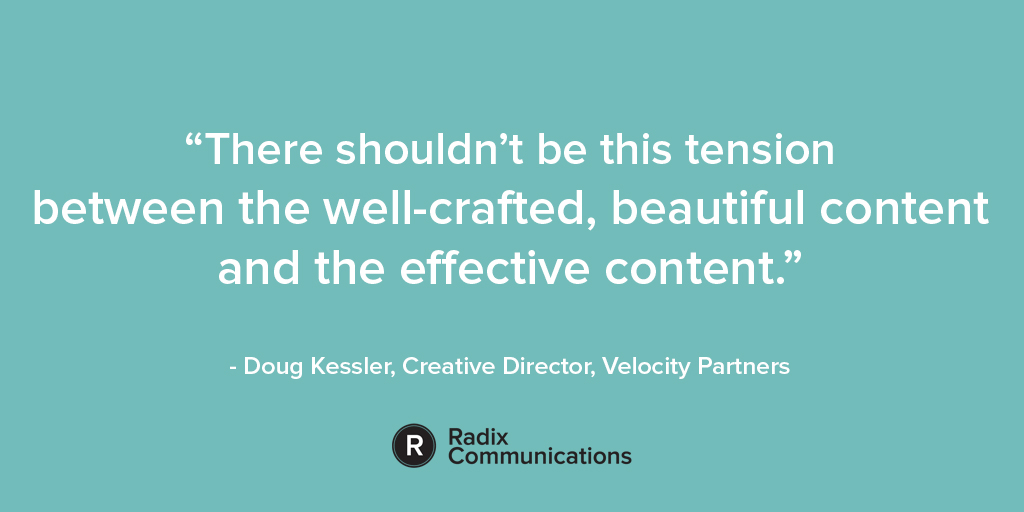Tweets. Blog posts. Explainer videos. Podcasts. Long-ass web pages. Interactive infographics. Hundred-page ABM reports. Even board games. Each of these marketing formats has a different style and function. But they all have one big thing in common.
Whether it’s the tiniest social seed or a big ol’ whitepaper, we categorise them all under one abstract and indeterminable word: content.
And Mat Harper, EMEA marketing chief of staff at Palo Alto Networks, believes that’s a problem.
Our recent content obstacles survey revealed that 68% of B2B marketers aren’t proud of even half their own work. In our drive to find out why, we outlined six obstacles to creating great content, from stakeholder interference to conflicting priorities. But Mat thinks we need to dig deeper.
In an interview for the survey report, he said we need to reconsider how we actually talk about creative marketing assets in B2B. More specifically, that we need to stop labelling everything as ‘content’ that should yield certain results. Because by doing so, he thinks we lose something equally important – the space for creativity.
And when we asked him how and why, he made some intriguing points. So we’ve put together the full interview for you. Here’s what he had to say…
Radix: You’ve seen the survey results. 37% of marketers say they’re only proud of a handful of work, ever. And 3% said they’d never produced work to be proud of. Having worked in B2B tech marketing for years, did you feel a sense of familiarity in these figures? Did anything make you really stop in your tracks?
Mat: “A lot of them made sense, and there’s definitely a feeling of familiarity there – I recognised many of the points in the observations from my own experiences.
“But one thing that really stood out to me, and we’re taking a bit of a step away here, is the impact of how we refer to all marketing content as just ‘content’. It’s a strange place we’ve put ourselves in.
“If you were a creative person, would you like your work to be defined as ‘content’? I certainly wouldn’t.”
“For a long time, and for the majority of my career, the word ‘content’ has been an umbrella term that encompasses everything – everyone from social media influencers to marketing professionals are using it. It’s always: ‘What is the content? We need more content.’
“And I think we need to understand where it’s come from. Would you refer to an artist’s work as ‘content’? No. So we have to stop and think – if you were a really creative person, and had fully poured yourself into your work, would you like it to be defined just as ‘content’? I certainly wouldn’t.”
Radix: But how does the catch-all word ‘content’ actually create limitations for B2B marketers?
Mat: “When we think about ‘content’, we’re always thinking about it as something that must drive to a result or outcome. And that might not be the smartest idea.
“We’ve got to a point where we’re completely data-driven and obsessed with ROI. We only focus on how many leads content engages with, or how many click-throughs it sees. And we have to ask ourselves: are they actually business results we’re talking about – is a clickthrough a business result? Do we even necessarily need to build content with a specific business result in mind?
“Because when you look at what some people are saying in the content obstacle survey results, it’s clear they’re not satisfied with what they’re producing. They think that in the drive to produce effective ‘content’, there’s too much influence from others, and too many people have their hands in sign-off.
“Can you really be proud something that’s just ‘content’ created by committee? Maybe you can’t.”
“If you are a creative person, the more people add their opinion or want to make changes, the further away it moves from your vision or plan. And can you really be proud or take ownership of something that’s not really you, that’s just ‘content’ that’s created by committee on behalf of the company? The more I think about it, the more I realise – maybe you can’t.
“The idea phase of content creation is brilliant. I get to dive into a project I’m passionate about. But often I see people stop there, because it’s near-impossible to justify an idea that came naturally. There’s no point in starting.
“Any really original idea can become the victim of its own success; it gets a reputation within your organisation, and suddenly it’s like people are putting gambling chips on what you’re creating.
“As the stakes get higher, ideas get interrogated. You need to predict the business benefit, or the pipeline, and justify yourself on all these levels, which is not where the idea came from. It’s demotivating.”
Radix: But the copy we write does have to have a business impact – we’re not just making art. So how can marketers align that with creating content they’re proud of? And as a tech marketing chief of staff, how would you suggest our readers find that balance?
Mat: “I’m not an idealist who thinks everyone should be a creative artist who expresses themselves on a canvas every day at work. Marketing has a role, and we have to produce ROI and business results for the company. But who’s to say the creator should be focused on that?
“Maybe, to get the best business impact, we should allow our employees who have expertise, passions and interests – and understand our customers – to express that, and have a bit of hope that it will resonate with human beings. Because that’s who we’re marketing to: human beings who can connect on an emotional, personal level.
“We’re marketing to human beings who connect on an emotional level… Perhaps we should allow people to express themselves.”
“Perhaps we should even allow people to express themselves as a journalist would. Within the remit of the role and company values, let your employees find what’s interesting to them, something they can put their stamp on, be proud of and stand behind. Give them the confidence and freedom to go build that on their own. And let that resonance become their measure of success.
“Then it puts the onus on the marketing operations team to figure out how we make the most of that impact, and build the systems to translate it into results.”
Radix: it would be unusual for marketers to be given the freedom to play with content creation without establishing a watertight business case first. Do you think it’s realistic?
Mat: “I think it could be in small doses. Marketers are always having to justify their worth, and their place in the company. That makes it difficult for them to spend time on something that isn’t easily measurable or doesn’t quickly show ROI – which can lead to a lack of originality.
“But you can manage creativity into an organisation; you just need to be realistic about what is possible.
“Marketers are always having to justify their worth, and their place in the company. That can lead to a lack of originality.”
“I once worked with a manager who didn’t like people to have job roles that were too defined. She’d happily encourage someone who had come up with an idea to go away and produce that work, regardless of their job title. To her, your role is only defined by the eventual outcome of what that role needs to be – how you get there is up to you.
“And that’s a great example of how to build space for creative freedom into a large company without losing sight of the results.
“The only difficult part, is where do you draw the line? You can give people the extra space and time to be creative, but at some point you need to measure the results of that decision, so you can decide whether that time was invested well. And that’s a real challenge.”
Can creative space help you find original concepts and great results?
Mat’s view might sound controversial to you. Especially if you’re currently fighting for a marketing budget that’s been merciless hacked down.
However, the survey results do show the importance of making space for creativity. When we asked content writers and creators ‘what is it about your best content that makes you proud?’, 39% said clever, or original concepts. Yet 75% of the same group aren’t proud of even half their own work.
When we put the same question to CMOs and directors, the tensions became clearer. The results were dramatically reversed – only 18% said clever concepts, while 45% said business results. From those signing off, there is more of an emphasis on business outcomes than originality. But that’s not the only thing preventing marketers from being more creative.
High workloads also play a role. The less time you have to create something, the more tempted you may be to resort to safe, tried-and-tested methods. 9 out of 10 marketers said workload gets in the way of great content. And those who said this was a ‘big problem’ were 25% less likely to say their best content had a clever, original concept.
Making space for originality doesn’t mean you have to reinvent your entire strategy, or should start using every weird and wonderful format you can find. Start small – perhaps with headline formats, subject lines or customer quotes – rigorously collect the results and use that data to justify your choice. Then you can continue to build from there. You can find more helpful tips here.
To quote Doug Kessler (also in the survey report): “There shouldn’t be this tension between the well-crafted, beautiful content and the effective content.”
In other words, the first step is proving that great content works.
Thanks again to Mat Harper of Palo Alto Networks for being so generous with his time and experience.




